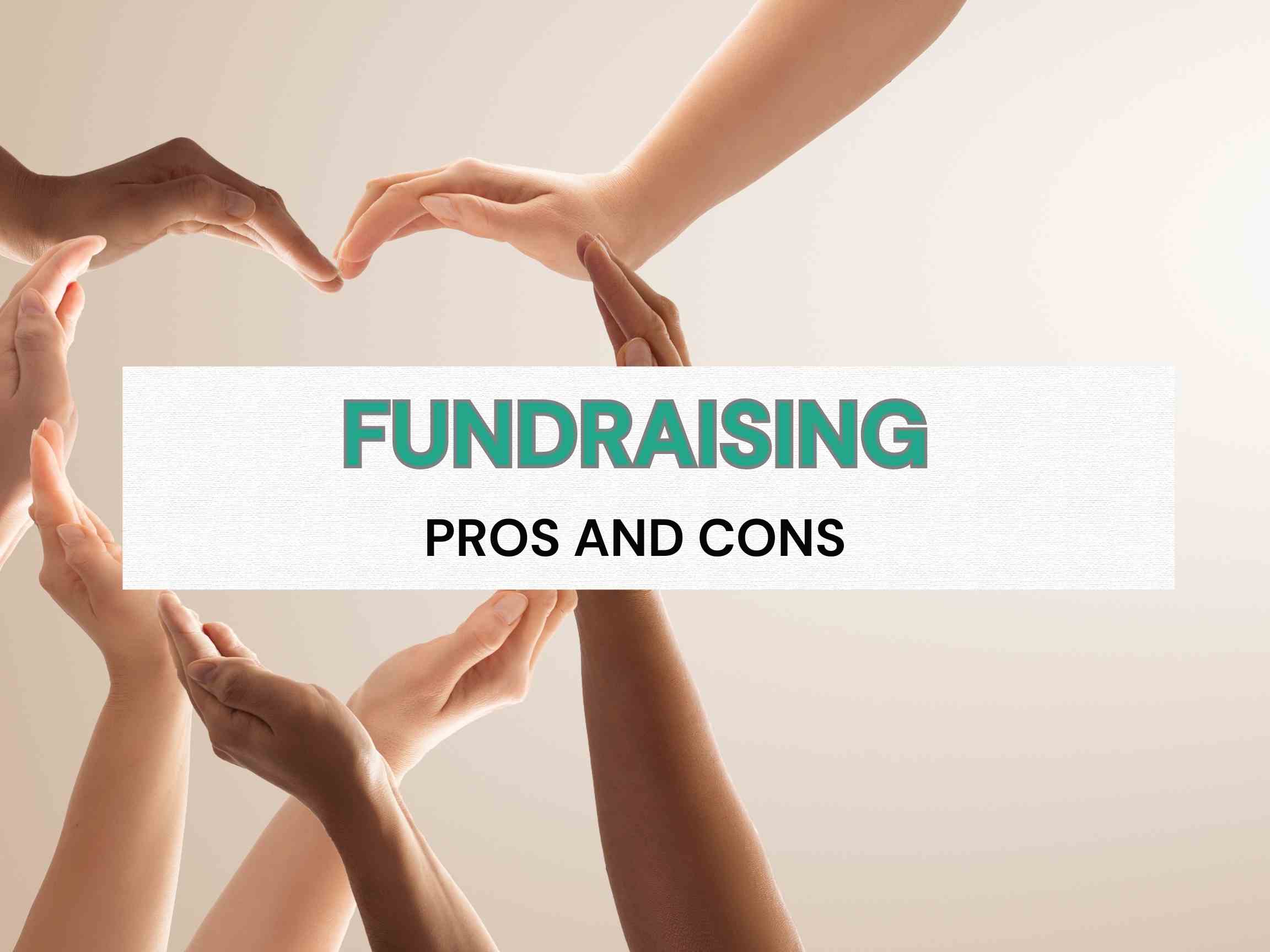9 Advantages and Disadvantages of Fundraising: Full Evaluation
This post may contain affiliate links. If you purchase through one of these links, I may receive a small commission at no extra cost to you. As an Amazon Associate, I earn from qualifying purchases.

Want to know the advantages and disadvantages of fundraising? Wondering if the benefits of fundraising truly outweigh the challenges of fundraising?
Fundraising is a critical component of the nonprofit sector, providing organizations with the resources they need to achieve their missions and make a positive impact on the world. According to NPT, Americans gave a whopping $484.85 billion in 2021 towards fundraising. This figure may have gone up further in 2022.
But like with every approach, there are certain advantages and disadvantages of fundraising. Fundraising can help organizations build strong relationships with donors and achieve their goals, it can also be costly, time-consuming, and lead to ethical concerns. In fact, the difference between donation and fundraising is that one is voluntary while the latter is not. Fundraising requires more effort and as a result comes with its own set of pros and cons.
In this article, we will explore the advantages and disadvantages of fundraising, providing insights and strategies to help organizations navigate these challenges and build successful fundraising campaigns. We will explore the benefits and drawbacks of fundraising for the organization and the people involved in the process of fundraising.
Advantages of Fundraising / Benefits of Fundraising
1. Access to capital
Access to capital is easily the biggest reason why organizations engage in fundraising. Fundraising is the most direct way to raise capital and support programs, projects, and other initiatives of an organization.
So a school fundraiser is usually a way to raise capital for better school supplies, providing scholarships to students in need, helping school sports teams, etc.
Read related posts on school fundraising:
A church fundraiser, on the other hand, could be to raise capital for community service for those in need like orphans, senior citizens, widows, patients, etc.
Fundraising not only lets private organizations directly raise capital but is also the primary goal for which non-profits are set up.
2. Increased Visibility
Fundraising is an excellent way to increase an organization’s visibility or popularity.
Fundraising events attract visibility through newspapers and media coverage, word-of-mouth marketing, engagement with donors, partners, corporates, and contributing individuals, social media campaigning and promotions, and demonstration of success stories.
If dedicated efforts are taken to leverage these opportunities, visibility alone can become one of the biggest advantages of fundraising.
3. Diversification of Funding Sources
Many organizations depend on a single source of income to meet their organizational demands. Fundraising allows the organization to add a few more sources of funds in the form of donations, grants, fundraising galas, successful raffles, and events, etc.
This diversification of funding sources reduces the reliance on a single source and mitigates risks associated with funding volatilities.
Having an extra source of funding is particularly crucial for organizations working in education, health, animal welfare, environment, etc. as they allow the organizations to carry on their work without liquidity interruptions.
4. Opportunity to Build Relationships

Fundraising for foster care, children’s health, schools, eradication of diseases, animal welfare, etc. creates the need to reach out to large corporates, high-net-worth individuals, celebrities, community helpers, government officials, and other people or bodies with whom it may be impossible to build a rapport.
Social betterment causes are a unifying factor and the relationships built from such causes are one of the most reliable and trustworthy.
5. Promotion of Innovation
Organizations often put innovation on the back burner on their list of priorities due to a lack of funds. But innovation and exploration of new ideas are a solid way of futureproofing and critical for the survival of an organization.
The funds raised from fundraising events allow organizations to pursue innovations, invest in research and development, and experiment with out-of-the-box ideas.
By embracing innovation and leveraging fundraising resources, organizations can remain agile, adapt to changing needs, and drive positive change in their communities.
6. Increased Community Engagement
As stated earlier, social betterment causes are unifying and have a massive potential of bringing together masses from across various sectors of the community.
Fundraising events provide an excellent platform to boost community participation in the form of charity walks, galas, raffles, fetes, etc.
Members of the community can come together to
- set up stalls to sell stuff, organize games, etc
- participate and perform at events like concerts, karaoke, etc.
- engage in promotional campaigns on social media
- collaborate in their official capacity by donating to raffles, sponsoring an event, etc.
- assist as volunteers or awareness campaigners.
7. Enhanced Reputation
Fundraising allows organizations to build solid goodwill. This fundraising advantage is unlocked as
– fundraising reporting often involves transparent disclosures. Complete transparency about an organization’s financial position, budgeting, fundraising goals, and appropriations significantly improves an organization’s overall reputation
– successfully raising funds also speak volumes about an organization’s management and efficiency and also builds credibility among stakeholders, community members, partners, and other collaborators.
– Fundraising efforts often communicate the organization’s impact and success stories. By sharing concrete examples of the positive outcomes achieved through their work, organizations can effectively demonstrate their ability to make a difference in their respective areas of focus. This showcases their dedication, and effectiveness, further enhancing their reputation.
8. Fostering a Sense of Ownership
This sense of ownership stems from the understanding that the contributions of each person associated with fundraising efforts directly impact the organization’s ability to achieve its goals.
As individuals become actively engaged in fundraising activities, they develop a shared responsibility and a sense of pride in being part of something meaningful. This ownership fuels motivation, loyalty, and a desire to see the organization thrive, leading to long-term support and sustained involvement.
Thus, involving employees, team members, and other stakeholders in fundraising events is a powerful way to foster a sense of ownership and harness their full potential
9. Flexibility
Fundraising improves flexibility by providing organizations with financial resources that can be allocated to different needs and priorities.
Unlike restricted grants or specific funding sources, fundraising efforts often generate unrestricted funds that can be utilized based on the organization’s evolving needs.
Thus organizations can take a call on the appropriation of funds based on the need of the hour. Funds can thus be freely allocated towards research and development, hiring of staff, improving infrastructure, etc.
Disadvantages of fundraising/ Challenges of fundraising
1. Time-Consuming
Fundraising requires a lot of planning and strategizing. The organization needs to determine the goal of fundraisers, the amount to be raised, the way in which it should be raised, etc.
After a few initial discussions and meetings for formalizing the broad strategy of the fundraiser, the execution of the plan needs to be initiated.
The execution efforts could range from
- meeting potential donors, setting up collaboration meetings,
- organizing events, galas, walks, fetes, or raffles
- mobilizing volunteers
- managing donation tracking systems,
- generating interest through social media campaigning or other publicity campaigns, etc.
In most cases, putting together a fundraising event could take up several weeks or months and fundraisers may not work as the best way to meet emergency liquidity needs.
2. Costly
Fundraising can be costly for a number of reasons.
Firstly, there are often significant upfront costs associated with planning and executing a fundraising campaign, such as marketing and advertising expenses, event planning costs, and staffing fees.
Additionally, fundraising efforts may require investment in technology and software to manage donor data and online giving platforms.
Finally, there are often fees associated with using third-party fundraising platforms or payment processors, which can add up quickly. All of these costs can eat into the amount of money raised, making it more difficult to achieve fundraising goals.
But if you want to overcome this fundraising challenge, read our post on ways to start a fundraising with no money
3. Risk of Failure
Let’s be real – not all fundraising efforts are successful. The risk of failure is one of the biggest disadvantages of fundraising. Unlike business decisions where the risk can be calculated to an extent and therefore minimized, the success of a fundraiser remains largely uncertain.
Despite the best efforts, organizations may not be able to meet their fundraising goals. The failure could be on account of improper planning and execution or due to factors beyond one’s control like wrong timing, unforeseen circumstances, donor fatigue (more on that below), overshooting budgets, etc.
Regardless of the cause of failure, a failed fundraising event often has a demoralizing effect on the stakeholders and the organization needs to find ways to mitigate the impact of failure or to look for other sources of income that pose lesser risks.
4. Donor Fatigue
Donor fatigue is a phenomenon that can occur when people are asked to donate to charitable causes too frequently or too aggressively. This can lead to a sense of burnout or apathy among potential donors, who may feel overwhelmed or frustrated by the constant requests for money.
Donor fatigue can be particularly problematic for fundraising efforts that rely on repeat donations or ongoing support from a small group of donors.
When donors become fatigued, they may be less likely to give or may give smaller amounts, which can make it more difficult for organizations to meet their fundraising goals. To mitigate donor fatigue, it is important for organizations to be strategic in their fundraising efforts, focusing on building long-term relationships with donors and avoiding excessive or intrusive requests for support.
5. Ethical Concerns

Fundraising, even though, undertaken for a good cause can often spill into areas that raise ethical concerns. These could be in the form of
– making emotional appeals
– guilt-tripping to extract more funds
– not making complete disclosures about facts to further fundraising causes
– misusing personal data of donors and community members
– concealing facts associated with use of funds, cost of fundraising etc.
Encouragement of such practices results in alienation of donors, half-hearted efforts by volunteers and other stakeholders and the overall failure of the fundraising movement.
6. Risk of Burnout
Fundraising can be a demanding and high-pressure job that requires a lot of time and energy. Fundraisers may be responsible for managing multiple campaigns and working long hours to meet their fundraising goals. This can lead to burnout, a state of emotional, physical, and mental exhaustion that can negatively impact a fundraiser’s health and job performance.
Burnout can also lead to high turnover rates in the fundraising industry, which can make it more difficult for organizations to build long-term relationships with donors and achieve their fundraising goals.
To mitigate the risk of burnout, organizations should prioritize the well-being of their fundraising staff by providing support, resources, and opportunities for professional development. Fundraisers should also prioritize self-care and set boundaries to prevent burnout from occurring.
7. Donor Demands
Donor demands can be a significant challenge for fundraisers.
Donors may have specific requests or expectations for how their donations should be used or may want to be more involved in the organization’s decision-making process. While it is important to listen to and engage with donors, these demands can be time-consuming and may distract from the organization’s overall fundraising goals.
To address donor demands, organizations should be clear about their mission and priorities and communicate these effectively to donors. They should also set realistic expectations for donor involvement and work to build strong relationships with donors based on trust and mutual understanding.
If flexibility is a non-negotiable for the functioning of an organization, the organization should avoid reliance on donors and instead engage in community fundraisers like galas, charity walks, raffles, fetes, etc.
8. Competition
Competition can be a significant challenge for fundraising efforts, particularly in crowded or oversaturated markets. When multiple organizations are competing for the same pool of donors, it can be difficult to stand out and attract support.
Additionally, competition can lead to a “race to the bottom” in which organizations engage in aggressive or unethical fundraising tactics like the ones stated above in order to gain an edge. This can not only damage the fundraising efforts on a short-term basis but completely erode the reputation and public trust in the organization.
To address competition, organizations should focus on building unique and compelling fundraising campaigns that showcase their mission and impact. They should also prioritize transparency, accountability, and ethical fundraising practices to differentiate themselves from other organizations and build trust with donors.
The timing of fundraising efforts also plays a critical role in determining the competition. October and November are peak fundraising seasons and events planned during that period often suffer due to stiff competition and donor fatigue.
9. Inefficiency
Inefficiency can be a significant disadvantage of fundraising efforts, particularly when organizations fail to use their resources effectively or prioritize the wrong fundraising strategies.
Inefficient fundraising efforts can lead to wasted time, money, and resources, and can make it more difficult for organizations to achieve their goals.
Additionally, inefficient fundraising practices can damage the reputation of the organization and erode the trust of donors and the public.
To address inefficiency, organizations should prioritize strategic planning and data-driven decision-making when it comes to fundraising. They should also regularly evaluate their fundraising efforts and adjust their strategies as needed to ensure that they are using their resources effectively and achieving their goals. By prioritizing efficiency, organizations can maximize their impact and build strong relationships with donors based on trust and accountability.
Fundraising Pros and Cons – FAQs
What is the hardest part about fundraising?
The hardest part about fundraising is proper execution. Inefficient execution of a fundraising event could result in failure, loss of reputation, and erosion of public trust.
To ensure proper execution, the fundraising planning must be strategic and data-driven. Volunteers, staff, and stakeholders must be carefully chosen and periodic evaluations must be done to ensure optimal use of resources.
What is the most important aspect of fundraising?
The most important part of fundraising is the planning stage. Not setting the right goals, choosing an improper method of fundraising, recruiting inadequately trained staff, and using the wrong tools are all planning failures that can negatively impact fundraising.
Save for later







